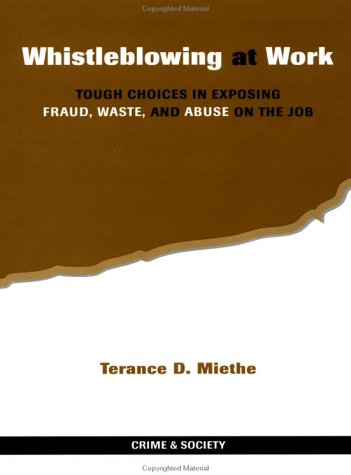How can employees in a variety of work settings best respond to organizational misconduct without getting burned? Using data from personal interviews and surveys of employees in various work settings, this book examines whistleblowingthe reporting by employees and former employees of illegal, unethical, and otherwise inappropriate conduct to someone who has the power to take corrective actionand its individual and organizational consequences. Early chapters define whistleblowing, identifying its major forms, and describing the problems with studying whistleblowers. The book then turns to the social and psychological attributes of whistleblowers, the situational factors, and the organizational characteristics that increase or decrease the likelihood of its occurrence. Subsequent chapters examine the individual and organizational consequences of whistleblowing, the legal rights and safeguards for whistleblowers, and particular case histories. The book concludes with a summary of strategic choices and practical advice for persons who are considering whether and how to report organizational misconduct. }Reactions to misconduct in the workplace are wide and varied.
Some people feel no major compulsion to speak out and their organizations seem content with this inaction. Other employees become strongly committed to disclosing the abuse to authorities outside the organization and take whatever steps are necessary even in the face of severe and swift organizational retaliation. What individual, organizational, and situational factors account for these differences? And how can employees in a variety of work settings best respond to organizational misconduct without getting burned?Using data from personal interviews and surveys of employees in various work settings, this book examines whistleblowingthe reporting by employees and former employees of illegal, unethical, and otherwise inappropriate conduct to someone who has the power to take corrective actionand its individual and organizational consequences. Early chapters define whistleblowing, identifying its major forms, and describing the problems with studying whistleblowers. The book then turns to the social and psychological attributes of whistleblowers, the situational factors, and the organizational characteristics that increase or decrease the likelihood of its occurrence.
Subsequent chapters examine the individual and organizational consequences of whistleblowing, the legal rights and safeguards for whistleblowers, and particular case histories. The book concludes with a summary of strategic choices and practical advice for persons who are considering whether and how to report organizational misconduct. }
- ISBN10 0813335493
- ISBN13 9780813335490
- Publish Date 24 December 1998
- Publish Status Out of Print
- Out of Print 13 December 2008
- Publish Country US
- Publisher Taylor & Francis Inc
- Imprint Westview Press Inc
- Format Hardcover
- Pages 264
- Language English
